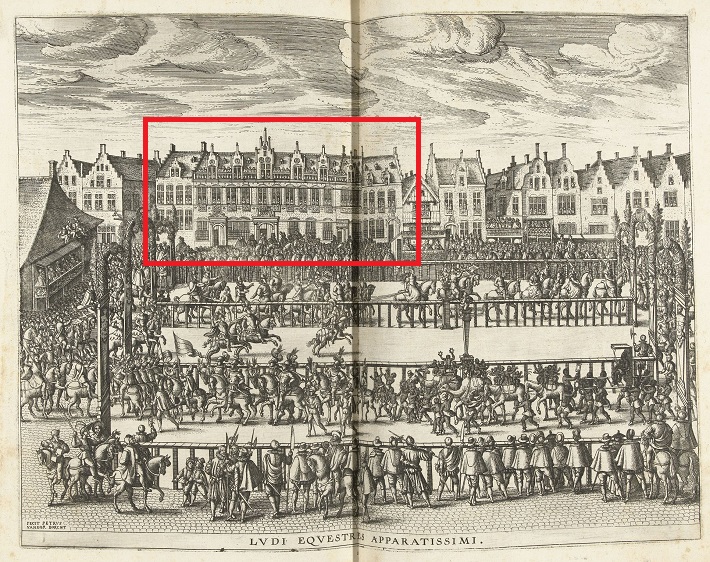Emmanuel Ximenez's Town Dwellings on the Antwerp Meir
In order to situate the many objects in Emmanuel Ximenez's extensive inventory of 1617 within their spatial and material context, we investigated the possibility of reconstructing the main wings, courtyard, garden, and out-buildings of his town dwelling. Between 1602 and 1617 Emmanuel and his wife, Isabel da Vega, lived successively in two different residences on the Meir. The couple's first property stood close to other family members' residences and was expensively embellished and enlarged to include a rear building and garden, regrettably, no documents on the spatial distribution or any visual representation of the old façade are known to exist.
The inventory of 1617 relates to the second Meir residence. The impressive façade of this official residence had been constructed in 1549 by the Spanish merchant Antonio del Rio, who united behind it three magnificent dwellings of which he himself inhabited only one. In 1564, when it was sold to the Portuguese merchant Loys Perez, Antonio's son Jeronimo inhabited the central part, which resembled a small palace, appropriate for receiving high-ranking visitors. In 1570 Anna of Austria, future spouse of Philip II, stayed there for a fortnight, which suggests that the residence must have met the requirements of courtly protocol.
By the time it was sold to Ferñao Ximenez in 1583, the building had been expanded even further, although it seems unlikely that it underwent many structural improvements or interior renovations between then and 1617. The stately presence of its unusually long façade on the Meir, with its many bays with Renaissance porches, balustrades, dormers and glazed windows drew the viewer's attention, and the elaborately carved architectural features in particular communicated the elevated social status of the owners. The façade was included in a print by Pieter van der Borcht (1595) as a fitting background for the tournament organized as one of the many festivities for the Joyous Entry of Archduke Ernest of Austria in June 1594. The Ximenez house had become the street's most striking landmark.
When Emmanuel Ximenez and his wife took up residence with their six children, staff and servants, they would have found a furnished set of rooms but must have also brought their own movables. When the inventory was made in 1617, listing the enormous number of goods took several days, and the perambulation led the notary into no less than forty-six different spaces. The inventory does not give us a clearer picture of how the rooms were arranged, however. The sources available for reconstructing the house are restricted to the property deed of 1583, the aforementioned print of 1595, the inventory of 1617, the façade's length in 1802, and the earliest cadastral plan of Antwerp of around 1825. For the interpretation of spatial distribution the lack of information on buildings at the rear, and on the number and location of staircases, is especially problematic. The inventory describes four floors and lists fifteen rooms or spaces that are provided with a hearth. While the function of many rooms on the ground and upper floors are named, and some spaces can clearly be situated on these floors, another group of spaces cannot be located on a particular level. Moreover, while more than one spiral staircase must have existed, and the house most probably also contained a stately staircase with straight flights, no stairs are mentioned at all. The 1583 deed is limited to the ground floor only, where it mentions nineteen spaces, but it also indicates the existence of a front and a back gate, and a front and a back house. The footprint shown on the cadastral plan of 1825 is inadequate for all the ground-floor spaces mentioned in the inventory. Quite noticeable is the absence of a back house parallel to the front house, situated between courtyard and garden, and behind which typically would have stood the stables and a rear gate. Presumably, this aisle was demolished during the late eighteenth or the early nineteenth century modernization by the Van Ertborn family. However, the predominantly asymmetric plan conforms to the typology of large urban dwellings in early modern Antwerp.
In 1617, Ximenez's second residence still reflected a sixteenth-century living pattern, the appearance of which may have been updated by interior decorations after the latest fashion. Its old-fashioned, but nevertheless still impressive, appearance radiated a sense of pedigree and exceptional social status. Today not one single stone remains: after their demolition at the start of the twentieth century, since the 1970s, warehouses for mass-produced clothing have replaced both of Emmanuel Ximenez's splendid residences.
Literature
Pohl, Hans. Die Portugiesen in Antwerpen (1567-1648): Zur Geschichte einer Minderheit. Wiesbaden: F. Steiner Verlag, 1977.
Ernstinger, Hans Georg. Raisbuch. Ed. P. A. F. Walther. Tübingen: Bibliothek des litterarischen Vereins in Stuttgart, 1877.
Thys, Augustin. "L'Ancienne commanderie de l'Ordre de Saint-Etienne, Place de Meir." Recueil des Bulletins de la Propriété (1881): 3-11.
Maclot, Petra. "Eureka, een Horta! De achtergevel van art nouveau-architect Victor Horta's 'Magasins de la Bourse/Innovation' aan de Meir." Info Antwerpse Vereniging voor Bouwhistorie & Geschiedenis 2 (2008): 4-13.

Pieter van der Borcht, Tournament with the Ximenez house in the background, engraving. In Johannes Bochius, Descriptio publicae gratulationis, spectaculorum et ludorum, in adventu Sereniss. Principis Ernesti Archiducis Austriae. Antverpiae: ex officina Plantiniana, 1595. 140-141. Image: © Rijksmuseum.


